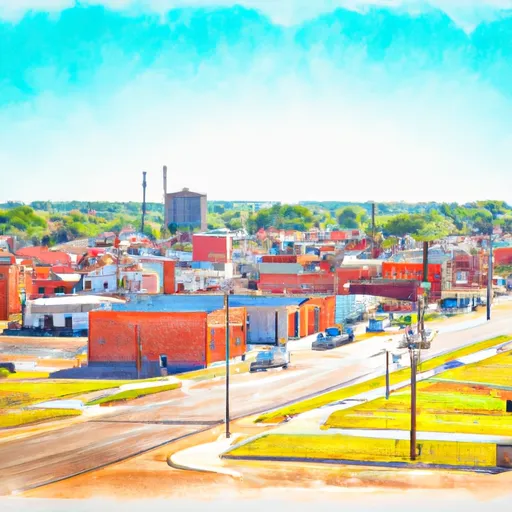-
 Snoflo Premium
Snoflo Premium
Get unlimited access to all our content
With no Ad interruptions! - Start Your Free Trial Login with existing account
Roosevelt
Eden Index
Climate
9.7
•
Recreation
1.7
•
Community
•
Safeguard
4.5/10

Roosevelt, Oklahoma is a small town located in Kiowa County, nestled in the southwestern part of the state. The town experiences a typical Great Plains climate, characterized by hot summers and cold winters. Summers are usually hot and dry, with average temperatures reaching the mid-90s (°F), while winters can be quite chilly with temperatures dropping to the mid-20s (°F). Precipitation is relatively low, with an average annual rainfall of about 25 inches and occasional snowfall during the winter months.
Hydrologically, Roosevelt is situated in the Washita River Basin, with the Washita River flowing nearby. The area is also home to several small creeks and ponds, contributing to the local hydrology. These water sources provide opportunities for fishing, boating, and other water-based recreational activities.
Outdoor recreation in Roosevelt includes activities such as hunting, hiking, camping, and bird-watching. The region is known for its diverse wildlife and natural beauty, offering opportunities to explore the surrounding prairies, woodlands, and waterways. The nearby Quartz Mountain Nature Park provides additional opportunities for outdoor enthusiasts, with hiking trails, rock climbing, and beautiful scenic vistas. Overall, Roosevelt, Oklahoma offers a variety of outdoor recreation options for nature lovers seeking to immerse themselves in the natural beauty of the Great Plains region.
What is the Eden Index?
The Snoflo Eden Index serves as a comprehensive rating system for regions, evaluating their desirability through a holistic assessment of climate health, outdoor recreation opportunities, and natural disaster risk, acknowledging the profound impact of these factors on livability and well-being.
Climate Health Indicator (CHI): 9.7
Roosevelt receives approximately
736mm of rain per year,
with humidity levels near 79%
and air temperatures averaging around
16°C.
Roosevelt has a plant hardyness factor of
7, meaning
plants and agriculture in this region tend to thrive during the non-winter months.
By considering the ideal temperature range, reliable water supplies, clean air, and stable seasonal rain or snowpacks, the Climate Health Indicator (CHI) underscores the significance of a healthy climate as the foundation for quality living.
A healthy climate is paramount for ensuring a high quality of life and livability in a region, fostering both physical well-being and environmental harmony. This can be characterized by ideal temperatures, reliable access to water supplies, clean air, and consistent seasonal rain or snowpacks.
Weather Forecast
Streamflow Conditions
North Fork Red
Area Rivers
North Fork Red
Snowpack Depths
North Fork Red
Reservoir Storage Capacity
North Fork Red
Groundwater Levels
Recreational Opportunity Index (ROI): 1.7
The Recreational Opportunity Index (ROI) recognizes the value of outdoor recreational options, such as parks, hiking trails, camping sites, and fishing spots, while acknowledging that climate plays a pivotal role in ensuring the comfort and consistency of these experiences.
Access to outdoor recreational opportunities, encompassing activities such as parks, hiking, camping, and fishing, is crucial for overall well-being, and the climate plays a pivotal role in enabling and enhancing these experiences, ensuring that individuals can engage in nature-based activities comfortably and consistently.
Camping Areas
| Campground | Campsites | Reservations | Toilets | Showers | Elevation |
|---|---|---|---|---|---|
| Foss State Park | None | 1,705 ft | |||
| Cordell Park | None | 1,530 ft | |||
| Hobart Lions Club RV Park | 8 | 1,546 ft | |||
| Lake Frederick Park | 150 | 1,217 ft | |||
| Great Plains State Park | None | 1,424 ft |
Nearby Fishing
Nearby Ski Areas
Catastrophe Safeguard Index (CSI):
The Catastrophe Safeguard Index (CSI) recognizes that natural disaster risk, encompassing floods, fires, hurricanes, and tornadoes, can drastically affect safety and the overall appeal of an area.
The level of natural disaster risk in a region significantly affects safety and the overall livability, with climate change amplifying these risks by potentially increasing the frequency and intensity of events like floods, fires, hurricanes, and tornadoes, thereby posing substantial challenges to community resilience and well-being.
Community Resilience Indicator (CRI):
The Community Resilience Indicator (CRI) recognizes that education, healthcare, and socioeconomics are crucial to the well-being of a region. The CRI acknowledges the profound impact of these elements on residents' overall quality of life. By evaluating educational resources, healthcare accessibility, and economic inclusivity, the index captures the essential aspects that contribute to a thriving community, fostering resident satisfaction, equity, and social cohesion.

